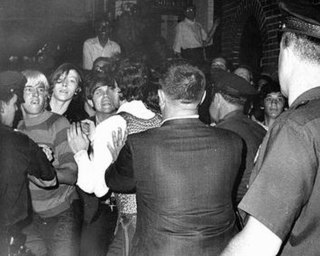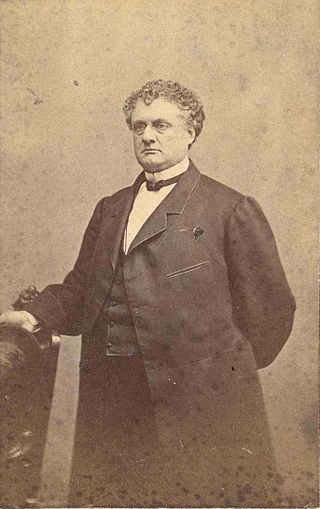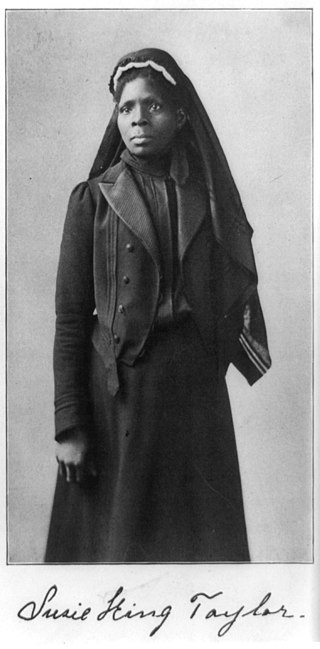Related Research Articles

The Stonewall riots, also known as the Stonewall uprising, Stonewall rebellion, or simply Stonewall, were a series of protests by members of the gay community in response to a police raid that began in the early morning hours of June 28, 1969, at the Stonewall Inn in the Greenwich Village neighborhood of Lower Manhattan in New York City. Patrons of the Stonewall, other Village lesbian and gay bars, and neighborhood street people fought back when the police became violent. The riots are widely considered the watershed event that transformed the gay liberation movement and the twentieth-century fight for LGBT rights in the United States.

The Boston Massacre was a confrontation in Boston on March 5, 1770, in which nine British soldiers shot several of a crowd of three or four hundred who were harassing them verbally and throwing various projectiles. The event was heavily publicized as "a massacre" by leading Patriots such as Paul Revere and Samuel Adams. British troops had been stationed in the Province of Massachusetts Bay since 1768 in order to support crown-appointed officials and to enforce unpopular Parliamentary legislation.

In the Heat of the Night is an American police procedural crime drama television series loosely based on the 1967 film and 1965 novel of the same title. It starred Carroll O'Connor as police chief Bill Gillespie and Howard Rollins as police detective Virgil Tibbs, and was broadcast on NBC from March 6, 1988, until May 19, 1992, then on CBS from October 28, 1992, until May 16, 1995. Its executive producers were Fred Silverman, Juanita Bartlett, and O'Connor. This series marked Carroll O'Connor’s return to a series for the first time on NBC and later returned to CBS after Archie Bunker's Place ended back in 1983.

A speakeasy, also called a blind pig or blind tiger, was an illicit establishment that sold alcoholic beverages. The term may also refer to a retro style bar that replicates aspects of historical speakeasies.

Madge Augustine Oberholtzer was a white American woman whose rape and murder played a critical role in the demise of the second incarnation of the Ku Klux Klan. In March 1925, while working for the state of Indiana on an adult literacy campaign, Oberholtzer was abducted by D. C. Stephenson, Grand Dragon of the Indiana Klan. Holding her captive in his private train car, Stephenson raped and tortured her. Oberholtzer died from a combination of a staphylococcal infection from her injuries and kidney failure from mercury chloride poisoning, which she took while held captive in an attempt to commit suicide.

Lucy E. Parsons was an American social anarchist and later anarcho-communist. Her early life is shrouded in mystery: she herself said she was of mixed Mexican and Native American ancestry; historians believe she was born to an African American slave, possibly in Virginia, then married a black freedman in Texas. In addition to Parsons, she went by different surnames during her life including Carter, Diaz, Gonzalez and Hull. She met Albert Parsons in Waco, Texas, and claimed to have married him although no records have been found. They moved to Chicago together around 1873 and Parsons' politics were shaped by the harsh repression of the Chicago railroad strike of 1877. She argued for labor organization and class struggle, writing polemical texts and speaking publicly at events. She joined the International Workingmen's Association and later the Knights of Labor, and she set up the Chicago Working Women's Union with her friend Lizzie Swank and other women.

"Combat Zone" was the name given in the 1960s to the adult entertainment district in downtown Boston, Massachusetts. Centered on Washington Street between Boylston Street and Kneeland Street, the area was once the site of many strip clubs, peep shows, X-rated movie theaters, and adult bookstores. It had a reputation for crime, including prostitution.

The Stonewall Inn, often shortened to Stonewall, is a gay bar and recreational tavern in the Greenwich Village neighborhood of Lower Manhattan, New York City, and the site of the Stonewall riots of 1969, which is widely considered to be the single most important event leading to the gay liberation movement and the modern fight for LGBT rights in the United States.

John Albion Andrew was an American lawyer and politician from Massachusetts. He was elected in 1860 as the 25th Governor of Massachusetts, serving between 1861 and 1866, and led the state's contributions to the Union cause during the American Civil War (1861-1865). He was a guiding force behind the creation of some of the first African-American units in the United States Army, including the 54th Massachusetts Infantry.

Annie Chapman was the second canonical victim of the notorious unidentified serial killer Jack the Ripper, who killed and mutilated a minimum of five women in the Whitechapel and Spitalfields districts of London from late August to early November 1888.
Josephine St. Pierre Ruffin was a publisher, journalist, civil rights leader, suffragist, and editor of the Woman's Era, the first national newspaper published by and for African-American women.

Bernard "Toots" Shor was the proprietor of the saloon and restaurant Toots Shor's Restaurant, in Manhattan. He ran three establishments under that name, but his first was located at 51 West 51st Street. He was a saloonkeeper, friend, and confidant to some of New York's biggest celebrities during that era.

Marsha P. Johnson was an American gay liberation activist and self-identified drag queen. Known as an outspoken advocate for gay rights, Johnson was one of the prominent figures in the Stonewall uprising of 1969.

Susie King Taylor is known for being the first African-Americsn nurse during the American Civil War. Beyond just her aptitude in nursing the wounded of the 1st South Carolina Volunteer Infantry Regiment, Taylor was the first Black woman to self-publish her memoirs. She was the author of Reminiscences of My Life in Camp with the 33rd United States Colored Troops, Late 1st S.C. Volunteers. She was also an educator to formerly bonded Black people in the postbellum South by opening various schools in Georgia. Taylor would also be a part of organizing the 67 Corps of the Women's Relief Corps in 1886.

SS Kronprinzessin Cecilie was an ocean liner built in Stettin, Germany in 1906 for North German Lloyd that had the largest steam reciprocating machinery ever fitted to a ship. The last of four ships of the Kaiser class, she was also the last German ship to have been built with four funnels. She was engaged in transatlantic service between her home port of Bremen and New York until the outbreak of World War I.


Robert Donston Stephenson was a British writer and journalist, chiefly known for having been made a potential suspect in the Jack the Ripper investigation and for his personal theory as to the identity of the murderer.
Patrick "Burly" Bohan was an American saloonkeeper and owner of The Doctor's, a popular dive bar at 95 Park Row, Manhattan and hangout for panhandlers and professional beggars known as the 'Bowery Bums'. Many of his patrons "preyed upon the public by simulating cripples." Bohan, according to crime historian Herbert Asbury, provided a locker for storing crutches and canes while these panhandlers spent their money on whiskey, rum and liquified camphor.
John Allen (1823–1870) was an American saloon keeper and underworld figure in New York City during the early-to mid-19th century. A former religious student, Allen was considered one of the most notorious criminals in the city and was known as the "Wickedest Man in New York". A public crusade against him, headed by lawyer and journalist Oliver Dyer, resulted in a reform movement known as the "Water Street revival".
Frank Stephenson was an American saloon keeper and underworld figure in New York City during the mid-to late 19th century. He was the owner of The Black and Tan, a popular Bowery basement bar located on Bleecker Street. It was one of the first saloons to cater to African-Americans and was a competitor against neighboring establishments such as Harry Hill's gambling resort and Billy McGlory's Armory Hall among others. He is also credited for opening the city's first and oldest "undisguised" gay bar, The Slide, also on Bleecker Street.
References
- 1 2 Petronius. New York Unexpurgated: An Amoral Guide for the Jaded, Tired, Evil, Non-conforming, Corrupt, Condemned, and the Curious, Humans and Otherwise, to Under Underground Manhattan. New York: Matrix House, 1966. (p. 192) OCLC 950624
- 1 2 Asbury, Herbert. The Gangs of New York: An Informal History of the New York Underworld. New York: Alfred A. Knopf, 1928. (p. 170) ISBN 1-56025-275-8
- ↑ O'Connor, Richard. Hell's Kitchen: The Roaring Days of New York's Wild West Side. Philadelphia: J. B. Lippincott, 1958. (p. 85) OCLC 1483793
- ↑ Walling, George W. Recollections of a New York Chief of Police: An Official Record of Thirty-eight Years as Patrolman, Detective, Captain, Inspector and Chief of the New York Police. New York: Caxton Book Concern, 1887. (pp. 487-88) OCLC 31433390
- ↑ O'Connor (p. 86)